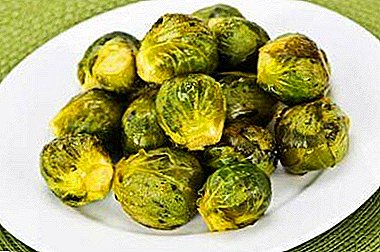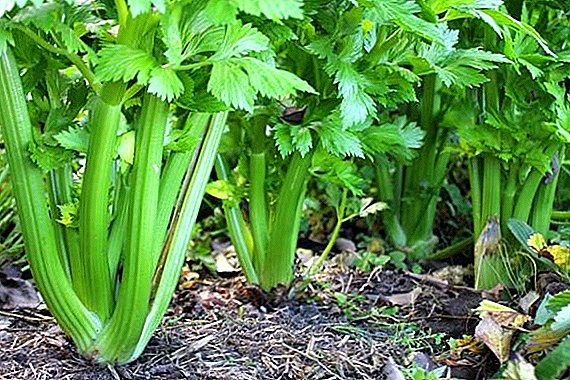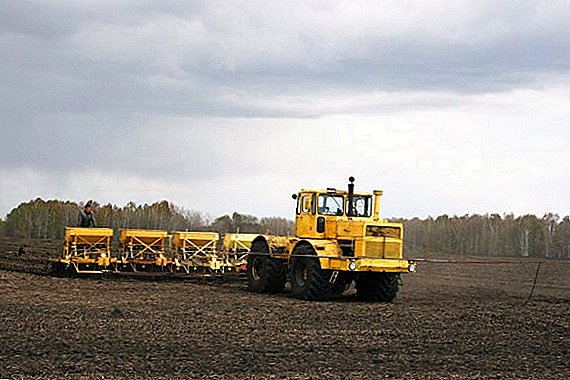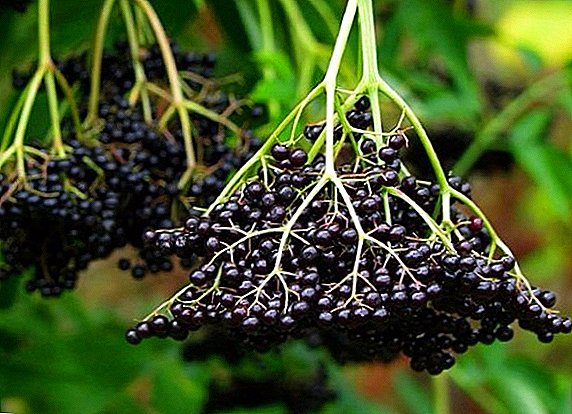 The elder family has about forty species. In our latitudes, black elder is most often planted.
The elder family has about forty species. In our latitudes, black elder is most often planted.
It is considered the most decorative variety, besides elderberry and color used for medicinal purposes.
Proper elderberry planting
Since ancient times, the elder was not deprived of attention, it was planted near the house, it was believed that the elder dares the evil spirits. Properly planted and well-groomed shrubs eventually will delight you with lush flowering and a good harvest of berries.
Did you know? AT ancient times, the peoples of the Balkans, conducting rituals call rain, used in their rituals branches of elderberry. Together with other plants, they dressed up a ritual doll, at the end of the rite the branches were removed and flooded.
Choosing a place for planting an elderberry seedling
An elderberry is not a capricious plant, but loves good lighting. Find a well-lit area for it on the north or east side of the plot. The plant tolerates a light shade, but the constant presence in the shade prevents full development.

Important! Elderberry varieties with bright-colored foliage are planted only in sunny areas, otherwise the plant fades and loses its entire decorative appearance.
The elderberry perfectly relates to the neighbors, besides, growing near the fruit or ornamental flowering bushes and trees will contribute to cross-pollination. This plant repels insects, so it is often planted next to a street toilet or a compost pit.
When and how to plant
 For growing black elderberry is best suited loamy soil. If the soil in your area is acidic, process it with lime. Elderberry planting occurs in spring and autumn, in warm weather. The hole is dug half a meter deep and fertilized with organic and phosphorus-potassium fertilizers. Before planting the soil at the bottom of the hole must be loosened. The seedling is placed in the hole, without deepening the root neck. Then sprinkle with clean soil, and on top of the fertilized and tamped. The seedling needs to be watered with 10 liters of water, after the soil has settled with water, tie the seedling to the peg. Until the plant takes root and takes root, it should be watered frequently. In the third year of life, the bush will give color.
For growing black elderberry is best suited loamy soil. If the soil in your area is acidic, process it with lime. Elderberry planting occurs in spring and autumn, in warm weather. The hole is dug half a meter deep and fertilized with organic and phosphorus-potassium fertilizers. Before planting the soil at the bottom of the hole must be loosened. The seedling is placed in the hole, without deepening the root neck. Then sprinkle with clean soil, and on top of the fertilized and tamped. The seedling needs to be watered with 10 liters of water, after the soil has settled with water, tie the seedling to the peg. Until the plant takes root and takes root, it should be watered frequently. In the third year of life, the bush will give color.
Some features of the care of black elderberry
Caring for an elderberry is not difficult, as long as it has enough light, moisture and timely trimming. This plant will decorate any garden with its color, and the glossy ink-colored berries on the branches of pink color will satisfy even the most sophisticated taste.
Interesting fact! Our ancestors, the Slavs, made elderberry amulets from branches and decorated their houses and gates, fences and other buildings of the courtyard. On the eve of Ivan Kupala, elder branches protected people and their homes from witches and other dark forces.
Watering the soil
Elderberry tolerates drought well, but it is preferable for it to be wet soil without stagnant water. Young plants need frequent watering, and adults cost rain. If summer does not indulge in precipitation, then additional watering is necessary. Especially carefully you need to monitor the soil moisture during the fruit ovary. In dry and hot weather, water under a bush 15 liters of water once a week. The basic rule in watering: the soil under the shrub should not dry out. After watering, the soil must be loosened, cleaned of weeds, so that the elderberry root system breathes easily and is not deprived of nutrients.
Attention! To preserve moisture in the soil in extreme heat, mulch the near-stem circle of the plant with peat or wood chips.
When and how to feed the soil
 On the rich nutrient soil, elderberry develops without fertilizing. But in the early spring after the winter avitaminosis and in the summer period of flowering, nitrogen fertilizing will not be superfluous. Solid fertilizers are scattered around the trunk and are buried in the soil by harrowing, and liquid formulations are applied during watering.
On the rich nutrient soil, elderberry develops without fertilizing. But in the early spring after the winter avitaminosis and in the summer period of flowering, nitrogen fertilizing will not be superfluous. Solid fertilizers are scattered around the trunk and are buried in the soil by harrowing, and liquid formulations are applied during watering.
From organic fertilizers, manure or compost, chicken dung, as well as tincture of manure and litter are preferable. Mineral fertilizers are needed if the plant has grown slowly or weakened. In this case, make a complex of mineral mixtures with irrigation. It is also possible to reinforce a weakened plant with urea. Carrying out these simple procedures, in the summer you will enjoy lush tassels of elder black flowers, and in the fall you will gather a rich harvest of healthy fruits.
Correct pruning
In early spring, sanitary pruning of damaged or frozen branches is carried out. Once every five years a cardinal pruning is carried out to rejuvenate old bushes. Cut short, leaving a quarter of the trunk. Thus, new branches grow and the bark of the trunk rejuvenates.
 A little trimming is done to form the crown. For a long time to think about how to cut a black elderberry is not worth it. Even if you accidentally mow more than you planned, the shrub will quickly recover. For several months, the elder will start up new shoots. Pruning is especially needed varieties of elderberry, which bear fruit. At the age of six bushes no longer tie fruit.
A little trimming is done to form the crown. For a long time to think about how to cut a black elderberry is not worth it. Even if you accidentally mow more than you planned, the shrub will quickly recover. For several months, the elder will start up new shoots. Pruning is especially needed varieties of elderberry, which bear fruit. At the age of six bushes no longer tie fruit.
Breeding methods
The best way to reproduce black elderberry is vegetative, with the seed method, species and varietal properties are extremely rarely preserved.
Seeds
Propagated by seeds is quite easy. Prepare the soil in advance, remove weeds, dig with fertilizer, loosen with a rake. In October, collect the seeds and sow in the beds to a depth of three centimeters at a distance of 25 cm from each other. Moisten sowing. In late autumn, crops will grow to 50 cm.
 For spring sowing the seeds must undergo a process of stratification. Soak the seeds for five days, constantly changing the water. After that, identify them in an airtight container with wet sand and store in the refrigerator for about two months. This improves seed germination. Upon expiration, remove from the refrigerator and store in a dry place. Spring planting is carried out in the same way as in the fall.
For spring sowing the seeds must undergo a process of stratification. Soak the seeds for five days, constantly changing the water. After that, identify them in an airtight container with wet sand and store in the refrigerator for about two months. This improves seed germination. Upon expiration, remove from the refrigerator and store in a dry place. Spring planting is carried out in the same way as in the fall.
Cuttings
Cuttings are planted in spring and in autumn. Before planting the cuttings, the acidic soil needs to be limed ahead of time (preferably a year). Cuttings cut into 20 cm, with two or three internodes.
Green cuttings are planted in greenhouse conditions, sprinkling the soil with a mixture of sand and peat. When the seedlings are strong, they are transplanted into open soil. The hole is made 50x50, humus, potassium sulfate and double superphosphate are added to the bottom. Deeper sapling is not necessary. The distance between them should be two meters. After landing it is necessary to water.
Lignified cuttings are planted immediately to a permanent place, in the same way as green ones. After the black elderberry seedling has been planted, it needs proper care — regular watering and loosening around the trunk. If woody cuttings were not planted in the fall, they should be stored in the cold and planted in the spring in the ground.
Fight against possible black elderberry pests
 Diseases of the elder black as such are unknown. This hardy plant practically does not get sick, occasionally being attacked by pests. To protect against aphids, shrubs are sprayed with insecticides in early spring. Voloton's solution (20 g per 10 l of water) helps from the same aphid and ticks. From folk methods, an infusion of onion peel or hot red pepper is considered effective. After a flowering period, the same infusion is sprayed on powdery mildew.
Diseases of the elder black as such are unknown. This hardy plant practically does not get sick, occasionally being attacked by pests. To protect against aphids, shrubs are sprayed with insecticides in early spring. Voloton's solution (20 g per 10 l of water) helps from the same aphid and ticks. From folk methods, an infusion of onion peel or hot red pepper is considered effective. After a flowering period, the same infusion is sprayed on powdery mildew.
Twice a year - before bud break and after fruiting - for prevention, the bushes are sprayed with a 2% Nitrafen solution. It is desirable to do this in order to destroy insects and fungi in the upper soil layer or in the bark. Copper sulfate solution is also used for prophylaxis. A seven percent urea solution is not only a fungicide and insecticide for protection, but also nitrogenous fertilizer that helps the development and growth of the plant.












